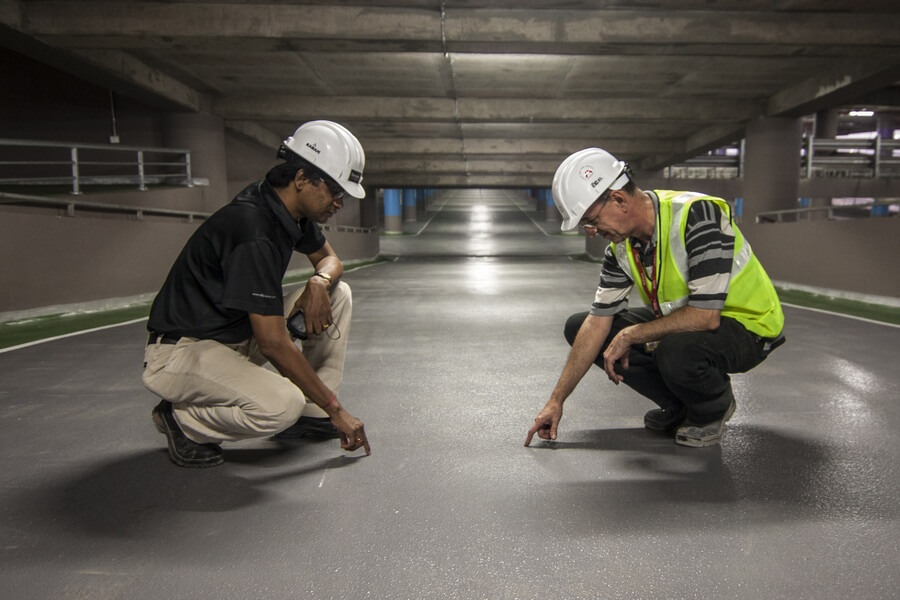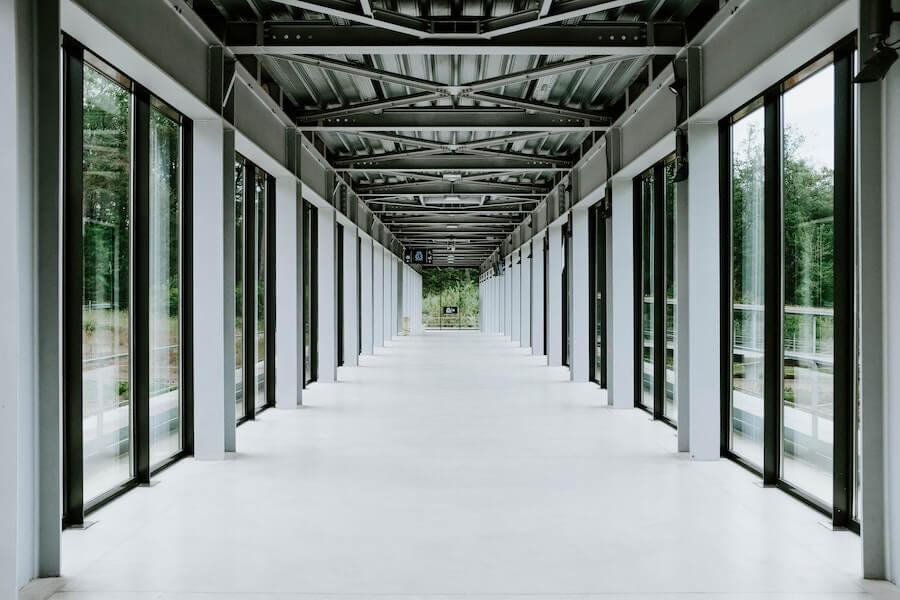Thinking about underfloor heating or planning your flooring installation? Adding this revolutionary heating system requires careful planning, and often involves levelling screed.
One of the biggest questions is how long it takes for screed to dry, as this affects the entire project timeline. In this article, we’ll explain how long does screed take to dry, the different types of screed, what influences drying times, and how you can speed up the process. Whether you’re using traditional or fast-drying screed, understanding these details can help you plan better and avoid delays.
Key Points:
- How long different types of screed take to dry.
- Factors that affect drying times.
- Tips to make screed dry faster.
- When it’s safe to proceed with flooring or foot traffic.
- What Is Screed?
- How Long Does It Take for Screed to Dry?
- Traditional Screed
- Fast-Drying Screed
- Flowing (Liquid) Screed
- Granolithic Screed
- Can I Speed Up the Drying Process?
- Benefits of Faster Drying
- How to Know When Your Screed Is Ready for Flooring
- When Can You Walk on Screed?
- Additional Factors That Influence Drying Time
- The Importance of Proper Curing for Long-Term Durability
- How to Check if Screed Is Ready
- Common Mistakes That Delay Drying and How to Avoid Them
- Let Us Help With Your Underfloor Heating Project With Levelling Screed
- FAQs
- Sources
What Is Screed?
Screed is a thin layer of material laid over a concrete subfloor to create a flat, smooth surface. It’s usually made from a mixture of sharp sand and cement, though industrial screed may include coarse aggregates for durability.
Screed is used to level out the floor, fill in uneven areas, or create a stable base for final flooring materials like tiles, carpet, or laminate. It can be applied directly over concrete, insulating materials, or underfloor heating pipes, depending on the type of screed used.
How Long Does Screed Take To Dry?
One of the most common questions when working with screed is, how long does it take for screed to dry? The answer depends on the type of screed used, the thickness of the layer, and the conditions in the room.
Knowing the drying time helps you plan your project better and avoid unnecessary delays. Here’s the most common types of screed that you will come across and will need to be aware of in order to track how long screed takes to dry.
Traditional Screed
Traditional screed, which is made of sharp sand and cement, is still the most common type used in many building projects. It usually has a ratio of 1 part cement to 4 parts sand. This type of screed generally takes about 24-48 hours to set, but the full drying process can take much longer.
On average, how long does floor screed take to dry? For traditional screed, it’s about 1mm per day under good conditions. If you lay a 50mm thick layer, it could take around 50 days to dry completely.
However, most builders wait at least 4 weeks before walking on it or laying the final flooring to ensure it has dried sufficiently.
Fast-Drying Screed
For projects that need to move quickly, fast-drying screed is often the best choice. This type of screed is specially formulated to set in 1-2 hours and can dry at a rate of around 10-15mm per day.
So, how long does screed take to dry? Usually, it can be ready for light foot traffic within a week, but it’s recommended to wait about 3-4 weeks if heavy foot traffic or furniture placement is planned. This quick-drying feature makes it ideal for time-sensitive projects where you want to get floors laid as soon as possible.
Flowing (Liquid) Screed
Flowing screed, also known as liquid screed, is designed for internal use, especially where underfloor heating is installed. It contains finer aggregates, making it smooth and easy to pour.
The typical setting time is between 6-48 hours, and the drying rate is about 1mm per day. Usually, you’re looking at around one week before it can support light foot traffic, but full curing often takes 28 days. It’s best to wait this period before installing flooring or subjecting it to heavy use.
Granolithic Screed
This type of screed is made with harder aggregates, making it highly durable. It’s often used in industrial or commercial settings with heavy foot traffic.
It takes roughly 12-28 hours to set, with a drying rate of about 2mm per day. To be fully dry and ready for heavy use, it can take approximately 2-3 weeks, depending on thickness and conditions.

Take a look at this chart below to get a better idea of how fast different kinds of screed dry:
| Type | Setting Time | Drying Time |
| Traditional (1:4) | 1-2 days | 1mm/day |
| Rapid Set (1:5) | 1-2 hours | 10-15mm/day |
| K-screed (1:4) | 6-12 hours | 25mm/week |
| Mapei Topcem (1:6) | 6 hours – 1 day | 5 days |
| Flowing Screeds | 6 hours – 2 days | 1mm/day |
| Granolithic | 12 hours – 1 day | 2mm/day |
| Truscreed (1:4) | 1-2 days | 25mm/week |
Can I Speed Up the Drying Process?
The answer is yes, you can sometimes speed up how long it takes for screed to dry, but only under the right conditions. Factors such as temperature, humidity, and the use of additives play significant roles.
- Environmental conditions: Higher temperatures and lower humidity will generally speed up drying. Proper ventilation, like fans or dehumidifiers, can help moisture evaporate faster.
- Additives: Some screed mixes include special additives that accelerate drying. For example, screeds designed for underfloor heating often contain components to help moisture escape quicker.
- Use of equipment: In professional settings, force drying using space heaters, onsite boilers, or industrial dryers can reduce drying times. But it’s important to follow manufacturer instructions carefully to avoid cracking or damaging the screed.
Benefits of Faster Drying
Reducing drying times can make a big difference in project schedules. When screed dries faster:
- Work can progress quicker, keeping the project on schedule.
- Floors can be laid sooner, saving time and money.
- The risk of damage or moisture-related issues is lowered.
- Workers can move on to the next stage without delays.

How to Know When Your Screed Is Ready for Flooring
Knowing how long the floor screed takes to dry helps you plan the next steps. Here are some general guidelines:
- Laminate: Wait about one week per centimetre of screed thickness, up to 4cm. For thicker layers, double that time.
- Tiles: Usually, screed should be firm enough to walk on after around three days, but wait at least a week before tiling, especially if using a heavy or large format tile.
- Carpet: Wait until the screed is as dry as possible to prevent mould. Once dry, clean the surface thoroughly before fitting the carpet.
For further guidance, use this table as a guideline when planning your screed drying times:
| Day | Activity | Notes |
| 1 | Prepare subfloor and lay screed | Follow manufacturer’s instructions for layer thickness |
| 2-3 | Initial setting and curing begins | Keep the room warm and ventilated |
| 4-7 | Light foot traffic (if applicable) | Use plastic covers to test moisture levels |
| 14 | Check moisture content and surface condition | Use moisture meter for confirmation |
| 21-28 | Full curing period before heavy flooring | Wait for maximum strength and stability |
Learn how underfloor heating is compatible with different flooring types with these guides:
When Can You Walk on Screed?
Light foot traffic can usually be supported after 24-48 hours, but it’s best to wait longer before moving heavy furniture or placing heavy loads on the surface. Remember, the screed is still curing at this point, and rushing it can lead to problems like cracks or uneven surfaces.
Additional Factors That Influence Drying Time
While you’ve covered the main factors like thickness, temperature, and additives, here are some other elements that can affect how long it takes for screed to dry:
- Subfloor Moisture Content: Before laying screed, the subfloor’s moisture level must be suitable. Excess moisture in the concrete or existing surface can significantly delay drying times. Using a moisture meter can help identify whether the subfloor needs drying or treatment. If moisture levels are high, you may need to wait longer or use moisture barriers to prevent issues later.
- Air Circulation: Poor ventilation can trap moisture, slowing down the drying process. Ensuring good airflow in the room during and after screed installation can help moisture escape, particularly in enclosed or poorly ventilated spaces.
- Seasonality: Work during colder, wetter months can extend drying times since low temperatures and high humidity slow moisture evaporation. Planning your project around the seasons or using climate control methods can help maintain the best drying conditions.
Guidelines set out by the British Standards (BS 8204) provide industry-approved procedures for screed installation and curing, ensuring your project meets quality and safety standards.
The Importance of Proper Curing for Long-Term Durability
Waiting the appropriate amount of time for the screed to dry isn’t just about project deadlines—it’s about ensuring a durable, stable floor in the long run. Proper curing prevents issues like cracking, surface dusting, or failure of the final flooring. Rushing this process can lead to costly repairs or replacements down the line.
How to Check if Screed Is Ready
Apart from waiting the recommended period, you can perform simple tests to confirm if the screed is dry enough:
- Plastic sheet test: Cover a small area with plastic and tape the edges. If moisture collects underneath after 24 hours, the screed isn’t dry yet.
- Pin test: Insert a moisture meter or a pin-type hygrometer into the surface. Readings below a certain percentage (as specified by the screed manufacturer) indicate it’s dry enough.
Common Mistakes That Delay Drying and How to Avoid Them
Even with the best planning, simple mistakes can extend the drying time of screed. Here are some pitfalls and tips to avoid them:
- Applying too thick a layer: Larger layers take longer to dry. Follow manufacturer guidelines for maximum thickness.
- Ignoring environmental conditions: Failing to control temperature and humidity can slow drying. Use heaters or dehumidifiers if necessary.
- Walking on screed prematurely: Support light foot traffic only after 24-48 hours. Heavy loads can cause surface damage.
- Not waiting long enough before tiling or laying flooring: Rushing can trap moisture, leading to future issues.
Let Us Help With Your Underfloor Heating Project With Levelling Screed
At Underfloor Heating Trade Supplies, we understand that choosing the right screed and adhesives is key to a successful flooring project. Our range of self levelling screed products offers a smooth, quick-drying solution ideal for underfloor heating systems. To ensure your final floor is secure and durable, explore our flooring adhesives. For those installing underfloor heating, our guide on the best adhesive for underfloor heating can help you make the right choice for a long-lasting finish.
Explore underfloor heating kits for sale now:
FAQs
How long until the screed is fully cured?
Most screeds reach their full cured strength at around 28 days. This is when they’re strongest and most reliable for heavy use and long-term durability.
Why is it important to let the screed dry properly?
Allowing screed to dry fully prevents future problems such as cracking, uneven surfaces, trapped moisture, or mould under flooring. Proper drying ensures long-lasting stability and performance.
Sources
BSI Knowledge (2003) BS 8204-1:2003+A1:2009. [online] Available at: https://knowledge.bsigroup.com/products/screeds-bases-and-in-situ-floorings-concrete-bases-and-cementitious-levelling-screeds-to-receive-floorings-code-of-practice [accessed 19/08/2025]
